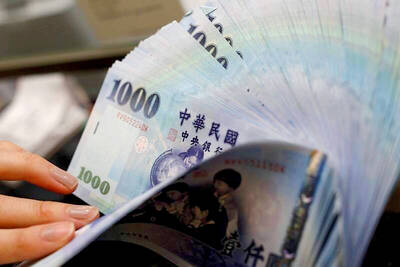Taiwanese manufacturers of the panels used to make flat-screen computer displays are set to grab an even larger slice next year of a global market they now control two-thirds of, analysts said yesterday.
By the end of next year, Taiwan is expected to control 73 percent of the thin-film transistor liquid-crystal display (TFT-LCD) panel market for computer monitors, up from 65 percent of this year, according to a report given yesterday by Li Hsiou-ling (勵秀玲) of the Market Intelligence Center (MIC) under the Institute for the Information Industry.
Falling prices have encouraged more people to buy new computer systems with flat-screen computer monitors and replace the bulky cathode-ray tube (CRT) screens in existing systems.
Worldwide LCD monitor sales are expected to jump almost 60 percent to around 51 million this year compared to last year, Li said, and will grow a further 35 percent next year to over 68.5 million.
"Price is a major factor in the rise of LCD monitors," Li said. "But for the average consumer the current average selling price of between US$300 and US$330 still needs to come down."
Local manufacturers AU Optronics Corp (
Dell outsources 55 percent of its production to Taiwanese manufacturers, MIC said yesterday, while HP places 90 percent of its LCD monitor orders here.
"I think it is possible for Taiwan's flat-panel makers to break the 70-percent barrier in the computer monitor market next year," said Martha Chen (
"They are increasing their production based in China which will probably win them more orders, and they have a ready supply of downstream suppliers," she said.
In a recent report, US-based researcher DisplaySearch already predicted that Taiwan's share of the global flat-panel monitor market would increase to 69 percent in the third quarter from 63 percent in the second.
But when panels for notebook computers, color-screen mobile phones, flat-screen televisions and other consumer products are taken into consideration, Taiwan falls into second place behind rivals in South Korea with 39 percent of the world's total TFT-LCD panel market, compared to South Korea's 43 percent, Japan's 14 percent and China's 3 percent, according to figures released yesterday by MIC.
Taiwan is not expected to overtake South Korea in the next twelve months as manufacturers here were slow in opening more efficient and advanced fifth-generation (5G) facilities which produce bigger panels, or more panels from an original piece of glass.
"The [South] Koreans are well ahead of Taiwanese companies," Chen said. "The Taiwanese are trying to close the gap."
With more than a year's head start on the Taiwanese, the South Koreans have fine-tuned production at their 5G plants so that the number of defective panels has been reduced drastically.
"South Korea's 5G production already has a yield of more than 80 percent," MIC's Ann Hsu (

Merida Industry Co (美利達) has seen signs of recovery in the US and European markets this year, as customers are gradually depleting their inventories, the bicycle maker told shareholders yesterday. Given robust growth in new orders at its Taiwanese factory, coupled with its subsidiaries’ improving performance, Merida said it remains confident about the bicycle market’s prospects and expects steady growth in its core business this year. CAUTION ON CHINA However, the company must handle the Chinese market with great caution, as sales of road bikes there have declined significantly, affecting its revenue and profitability, Merida said in a statement, adding that it would

i Gasoline and diesel prices at fuel stations are this week to rise NT$0.1 per liter, as tensions in the Middle East pushed crude oil prices higher last week, CPC Corp, Taiwan (台灣中油) and Formosa Petrochemical Corp (台塑石化) said yesterday. International crude oil prices last week rose for the third consecutive week due to an escalating conflict between Israel and Iran, as the market is concerned that the situation in the Middle East might affect crude oil supply, CPC and Formosa said in separate statements. Front-month Brent crude oil futures — the international oil benchmark — rose 3.75 percent to settle at US$77.01

RISING: Strong exports, and life insurance companies’ efforts to manage currency risks indicates the NT dollar would eventually pass the 29 level, an expert said The New Taiwan dollar yesterday rallied to its strongest in three years amid inflows to the nation’s stock market and broad-based weakness in the US dollar. Exporter sales of the US currency and a repatriation of funds from local asset managers also played a role, said two traders, who asked not to be identified as they were not authorized to speak publicly. State-owned banks were seen buying the greenback yesterday, but only at a moderate scale, the traders said. The local currency gained 0.77 percent, outperforming almost all of its Asian peers, to close at NT$29.165 per US dollar in Taipei trading yesterday. The

RECORD LOW: Global firms’ increased inventories, tariff disputes not yet impacting Taiwan and new graduates not yet entering the market contributed to the decrease Taiwan’s unemployment rate last month dropped to 3.3 percent, the lowest for the month in 25 years, as strong exports and resilient domestic demand boosted hiring across various sectors, the Directorate-General of Budget, Accounting and Statistics (DGBAS) said yesterday. After seasonal adjustments, the jobless rate eased to 3.34 percent, the best performance in 24 years, suggesting a stable labor market, although a mild increase is expected with the graduation season from this month through August, the statistics agency said. “Potential shocks from tariff disputes between the US and China have yet to affect Taiwan’s job market,” Census Department Deputy Director Tan Wen-ling